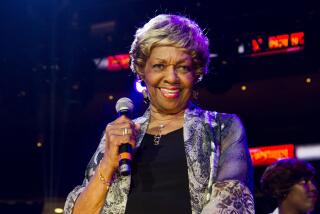Book review: ‘Baby, Let’s Play House: Elvis and the Women Who Loved Him’ by Alanna Nash
The facts and mythology of Elvis Presley’s life are so far-reaching that they’ve spawned dozens of books, examining the King of Rock ‘n’ Roll seemingly from every possible perspective. Except, oddly, for that portion of his audience he arguably was most eager to please throughout his life: women.
“I had already done three Elvis books, but I realized, ‘Wait a minute -- there hasn’t been a book that looked at him almost purely from the female perspective,” said veteran music journalist Alanna Nash, author of the new biography published this week, “Baby, Let’s Play House: Elvis and the Women Who Loved Him” (It Books, $27.99).
“Since he is probably the most important male sex symbol in history,” Nash said, “the idea seemed viable, and also because he was such a woman-centered man, mainly because of the closeness with his mother.”
Nash conducted interviews with 40 to 50 women who had contact of some sort with Presley during his life, including classmates, relatives, girlfriends and costars. Among the relationships she explores are those with actresses Ann-Margret, Cybill Shepherd, Raquel Welch, Mary Ann Mobley, Barbara Eden and Yvonne Craig; she also examines Presley’s ties to such pivotal early love interests as Dixie Locke, Barbara Hearn, June Juanico and Carolyn Bradshaw.
At the center of it all, emotionally and psychologically, is Elvis’ mother, Gladys, the onetime life of the party whose downward descent seemed to begin almost from the day she gave birth to the future King.
Because his twin brother died at birth, “From the moment Elvis was born, mother and son demonstrated a remarkable closeness,” writes Nash, also the author of biographies on Dolly Parton and newswoman Jessica Savitch, in addition to earlier works focusing on key members of Elvis’ entourage, including his manager, Col. Tom Parker and the circle of cronies known as “the Memphis Mafia.”
She argues that the already worrisome Gladys became incapable of nurturing her surviving child toward independence as an adult and that his brother’s death also left a crucial void in Elvis that no one, certainly none of his romantic partners, would ever be able to fill.
After three deaths in the immediate family before Elvis was 1, Gladys “clung to her son tighter than before, almost as if he were a shield against a treacherous and mercurial world, where disaster could strike at any second and take away all that mattered,” Nash writes.
Nash examines how that mother-son knot eventually doomed Elvis in his personal relationships and colored his working relationships and career choices.
She points out that many of the women Presley was attracted to physically resembled Gladys or his long-lost twin, and that many of them were 14 -- including the only one he ever married, Priscilla Beaulieu -- when they came into his life. It was at that age that Nash argues Elvis stopped developing emotionally.
If anything, “Baby Let’s Play House” heightens the heartbreaking aspects of Presley’s life.
He died in 1977 at the age of 42.
“His tragedy is not simply that he died too soon, without breaking his dependence on prescription drugs and realizing the enormity of his talent in projects that fed his creative Muse,” Nash writes in her epilogue, “but that he was forever trapped in a loop of dissatisfaction and suffering, stemming from the loss of his twin and the premature death of his mother, with whom he had been lethally enmeshed since childhood.”
More to Read
Sign up for our Book Club newsletter
Get the latest news, events and more from the Los Angeles Times Book Club, and help us get L.A. reading and talking.
You may occasionally receive promotional content from the Los Angeles Times.







